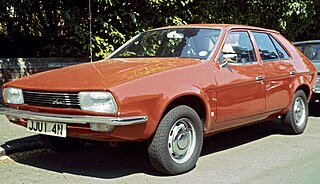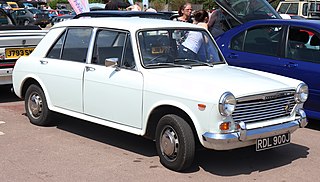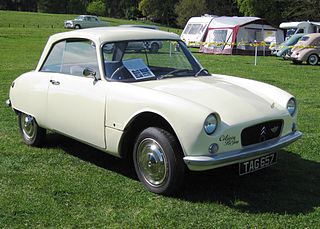Description
The system replaces the separate springs and dampers of a conventional suspension system with fluid filled displacer units which are interconnected between the front and rear wheels on each side of the vehicle.
Each displacer unit contains a rubber spring, and damping is achieved by the displaced fluid passing through rubber valves. The displaced fluid passes to the displacer of the paired wheel, thus providing a dynamic interaction between front and rear wheels. When a front wheel encounters a bump, fluid is transferred to the corresponding rear displacer, then lowers the rear wheel, hence lifting the rear, minimising pitch associated with the bump. [2] Naturally the reverse occurs when it is a rear wheel that encounters a bump. This effect is particularly good on small cars as their shorter wheelbases are more affected by pitching.
However, the key improvement over conventional suspension is that the front/rear interconnection allows the vehicle to be stiffer in roll than in pitch. Hence it is possible to design a compliant suspension - giving a comfortable ride - without suffering a penalty in terms of excessive roll when cornering. In roll, there is no transference of fluid from the displacers, and hence its internal pressure rises. The only "give" in the suspension occurs because of the inherent flexibility of the rubber springs. These are naturally stiff.
In pitch, as described above, fluid is displaced front to rear, and hence the pressure in the system stays effectively the same, and thus the suspension is much more compliant.
The design of the displacer units, and the way in which they are mounted means that as the suspension is compressed, the (roughly spherical) displacer deforms, and hence presents a larger area to the mounting plates. The pressure in the system is thus acting over a larger area, and hence applying additional force. This gives the suspension a sharply rising rate even in pitch, so that there is a strong tendency to return to equilibrium. Without this rising rate there would be no effective pitch resistance at all.
Cars with Hydrolastic suspension do, however, have a marked tendency to squat under acceleration, and to dive under braking (and for the rear end to sag under heavy loads). This requires clever design of the suspension components to minimise these forces, and to maximise the rising rate characteristic.
Hydragas
Hydragas is a type of automotive suspension system used in many cars produced by British Leyland and its successor companies.
Invented by British automotive engineer Alex Moulton, Hydragas is an evolution of the previous Hydrolastic system. Manufactured under licence by BTR AVS under the Dunlop brand at the historic Holbrook Lane site. It was first introduced in 1973 in the Austin Allegro and was later fitted to the 1975 Princess and its successor, the 1982 Austin Ambassador. Both systems attempt to address the ride-handling compromise of car suspension by interconnecting the suspension of the front and rear of the car in some way. Hydragas attempted to perform the same function and advantages as the hydropneumatic system developed by Citroën, but without its attendant complexity.
The heart of the system is the displacer units, which are pressurised spheres containing nitrogen gas. These replace the conventional steel springs of a regular suspension design. The means for pressurising the gas in the displacers is done by pre-pressurising a hydraulic fluid, and then connecting the displacer to its neighbour on the other axle. This is unlike the Citroën system, which uses hydraulic fluid continuously pressurised by an engine-driven pump and regulated by a central pressure vessel.
Despite early problems (the Allegro version of Hydragas was found seriously wanting), it was gradually developed into an effective and efficient alternative to steel springs on later BL/Rover Group models such as the Austin Metro and MGF. The Metro originally featured independent Hydragas units, with no fore/aft interconnection (the pipework was deleted on cost grounds, against the advice of Moulton). While the Metro was praised for its handling, and offered a significant improvement in ride quality over the Mini, it was criticised for its tendency to pitch and bounce on uneven roads - precisely the characteristics the interconnection was intended to remove. The revised Rover Metro had its suspension interconnected and went on to receive plaudits for the quality of its ride.
The Austin Maxi was the only in production car to feature both systems. The Maxi featured 1100 designed Hydrolastic units with the regulator valve fitted with the interconnection pipe. However, in 1978 production of Hydrolastic bottles at Dunlop came to an end and BL modified the Princess Hydragas bottles to fit. This involved fitting a new front subframe design, with a larger diameter horizontal chamber in the subframe. MGF was the last vehicle platform to use this design. The Hydragas system was dropped in favour of conventional suspension by Rover when BTR AVS sought to increase the price of the units substantially. After servicing the spares market for some years a buyer was found and the production line was sold.

The Mini is a small, two-door, four-seat car, developed as ADO15, and produced by the British Motor Corporation (BMC) and its successors, from 1959 through 2000. Minus a brief hiatus, original Minis were built for four decades and sold during six, from the last year of the 1950s into the last year of the 20th century, over a single generation, as fastbacks, estates, and convertibles.

Sir Alexander Arnold Constantine Issigonis was a British-Greek automotive designer. He designed the Mini, launched by the British Motor Corporation in 1959, and voted the second most influential car of the 20th century in 1999.

The Princess is a large family car produced in the United Kingdom by the Austin-Morris division of British Leyland from 1975 until 1981. The car inherited a front-wheel drive / transverse engine configuration from its predecessor, the Austin/Morris 1800 range. This was still unusual in Europe for family cars of this type and gave the Princess a cabin space advantage when compared with similarly sized cars from competing manufacturers.

A torsion bar suspension, also known as a torsion spring suspension, is any vehicle suspension that uses a torsion bar as its main weight-bearing spring. One end of a long metal bar is attached firmly to the vehicle chassis; the opposite end terminates in a lever, the torsion key, mounted perpendicular to the bar, that is attached to a suspension arm, a spindle, or the axle. Vertical motion of the wheel causes the bar to twist around its axis and is resisted by the bar's torsion resistance. The effective spring rate of the bar is determined by its length, cross section, shape, material, and manufacturing process.

Suspension is the system of tires, tire air, springs, shock absorbers and linkages that connects a vehicle to its wheels and allows relative motion between the two. Suspension systems must support both road holding/handling and ride quality, which are at odds with each other. The tuning of suspensions involves finding the right compromise. It is important for the suspension to keep the road wheel in contact with the road surface as much as possible, because all the road or ground forces acting on the vehicle do so through the contact patches of the tires. The suspension also protects the vehicle itself and any cargo or luggage from damage and wear. The design of front and rear suspension of a car may be different.

The Metro is a supermini car, later a city car that was produced by British Leyland (BL) and, later, the Rover Group from 1980 to 1998. It was launched in 1980 as the Austin mini Metro. It was intended to complement and eventually replace the Mini, and was developed under the codename LC8. The Metro was named by What Car? magazine as 'Car of The Year' in 1983 as an MG, and again as the Rover Metro in 1991.

Hydropneumatic suspension is a type of motor vehicle suspension system, designed by Paul Magès, invented by Citroën, and fitted to Citroën cars, as well as being used under licence by other car manufacturers, notably Rolls-Royce, Bmw 5-Series e34 Touring, Maserati and Peugeot. It was also used on Berliet trucks and has more recently been used on Mercedes-Benz cars, where it is known as Active Body Control. The Toyota Soarer UZZ32 "Limited" was fitted with a fully integrated four-wheel steering and a complex, computer-controlled hydraulic Toyota Active Control Suspension in 1991. Similar systems are also widely used on modern tanks and other large military vehicles. The suspension was referred to as fr:Suspension oléopneumatique in early literature, pointing to oil and air as its main components.

The Morris Minor is a British economy family car that made its debut at the Earls Court Motor Show, London, in October 1948. Designed under the leadership of Alec Issigonis, more than 1.6 million were manufactured between 1948 and 1972 in three series: the Series MM, the Series II, and the 1000 series.

BMC ADO17 is the model code used by the British Motor Corporation (BMC) for a range of large family cars manufactured from September 1964 to 1975. The car was initially sold under the Austin marque as the Austin 1800, then by Morris as the Morris 1800, by Wolseley as the Wolseley 18/85, and later the Austin 2200, Morris 2200 and Wolseley Six. The 1800 was voted European Car of the Year for 1965.

The BMC ADO16 is a range of small family cars built by the British Motor Corporation (BMC) and, later, British Leyland. Launched in 1962, it was Britain's best-selling car from 1963 to 1966 and from 1968 to 1971. The ADO16 was marketed under various make and model names; however, the Austin 1100 and Morris 1100 were the most prolific of all the ADO16 variants. The car's ubiquity at the height of its popularity led to it simply being known as the 1100 (eleven-hundred) in its home market.

The Wolseley 15/60 is an automobile which was produced from 1958 to 1961, and then, as the Wolseley 16/60, from 1961 to 1971. The 15/60 was the first of the mid-sized Pininfarina-styled automobiles manufactured by the British Motor Corporation (BMC). Launched in December 1958 as part of BMC's Wolseley brand, the design would eventually be shared with seven other marques. All of the cars were updated in 1961 with a larger engine and new model designations. The Wolseley 16/60 was the last, in production until 24 April 1971.

Alexander Eric Moulton was an English engineer and inventor, specialising in suspension design.

The BMC E-series engine is a line of straight-4 and straight-6 overhead camshaft automobile petrol engines from the British Motor Corporation (BMC). It displaced 1.5 L or 1.8 L in four-cylinder form, and 2.2 L or 2.6 L as a six-cylinder. The company's native United Kingdom market did not use the 2.6 L version, which was used in vehicles of Australian and South African manufacture. Although designed when the parent company was BMC, by the time the engine was launched the company had become British Leyland (BL), and so the engine is commonly referred to as the British Leyland E-series engine.

The Mark I Mini (1959–1967) was the first version of British Motor Corporation's Mini. It is characterised by its sliding windows, external door hinges and "moustache" grille. In the United Kingdom the Mark I was produced between 1959 and 1967, with production in Australia continuing until 1970. The Mini Mark I was sold under both Austin and Morris marque names.

The Morris Nomad is a car that was produced in Australia by British Leyland Motor Corporation of Australia from 1969 to 1972. It is a hatchback version of the Morris 1500 sedan, itself a locally produced variant of the British BMC ADO16 design with a larger 1500 cc engine.

The Austin 3-Litre is a British saloon car that was introduced by Austin at the London Motor Show in 1967. Codenamed ADO61, the car was intended to be BMC's offering in the 3-litre executive class and was originally designed in the early 1960s, before the British Leyland era. Unlike the visually similar front-wheel drive Morris 1800 range, the 125 bhp 3-litre engine drove the rear wheels through a conventional 4-speed gearbox.

The Austin Kimberley and Austin Tasman "X6" models are a pair of Leyland Australia-designed front-wheel-drive sedans based on the Austin 1800 (ADO17) platform, that were produced from 1970 to 1972 and sold by Austin. At the time of the X6 being launched onto the Australian market it was quite an advanced design in comparison to the other competitors from Ford, Holden and Chrysler, whose rear-wheel drive, conventionally sprung underpinnings dominated the market at the time.

The Citroën Bijou is a small coupé manufactured by Citroën at the premises they had occupied since 1925 in Slough, England. The Bijou was assembled from 1959 until 1964. It was based on the same platform chassis as the Citroën 2CV, sharing its advanced independent front to rear interconnected suspension. The car's appearance was thought to be more in line with the conservative taste of British consumers than the utilitarian 2CV.
There have been a number of Mini concept cars, produced to show future ideas and forthcoming models at international motorshows.
The Amalgamated Drawing Office was the design and engineering department of the British Motor Corporation. From the early 1950s, the resulting projects of the office were known by the initials ADO. The numbers were assigned to vehicle and engineering projects, some resulting in production models. The ADO numbering system continued well beyond BMC's absorption into British Leyland, who continued to use the convention until the late 1970s.
















